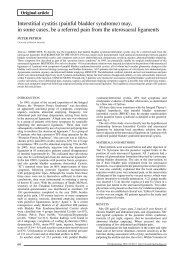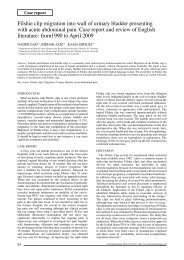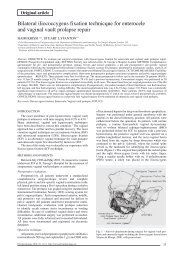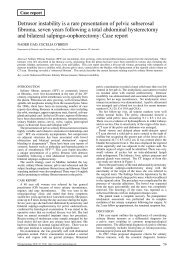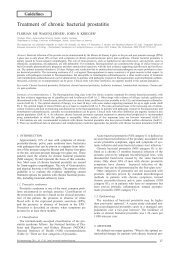This Issue Complete PDF - Pelviperineology
This Issue Complete PDF - Pelviperineology
This Issue Complete PDF - Pelviperineology
You also want an ePaper? Increase the reach of your titles
YUMPU automatically turns print PDFs into web optimized ePapers that Google loves.
Case report<br />
A simple technique for intravesical tape removal<br />
STAVROS CHARALAMBOUS - CHISOVALANTIS TOUNTZIARIS<br />
CHARALAMBOS KARAPANAGIOTIDIS - CHARALAMBOS THAMNOPOULOS PAPATHANASIOU<br />
VASILIOS ROMBIS<br />
Department of Urology, “Hippokratio” General Hospital of Thessaloniki - Thessaloniki, Greece<br />
Abstract: The tension-free vaginal tape (TVT) procedure has become the most frequently performed surgical technique for the treatment of<br />
stress urinary incontinence with cure rates reported at greater than 85%. 1-3 Nevertheless, these excellent results are associated with specific<br />
complications such as bladder perforation 2-4 and vaginal, urethral and bladder erosion. 5-8 Any undetected perforation or gradual erosion of the<br />
bladder wall may lead to a delayed recognition of an intravesical mesh. Herein, we describe a novel technique concerning mesh removal which<br />
requires minor instrumentation and results in the effective resection of intravesical tape.<br />
Key words: Intravesical; Sling; Stress urinary incontinence; Tension-free vaginal tape.<br />
CASE REPORT<br />
A 63-year-old woman presented with recurrent urinary<br />
tract infections and dysuria, six months following a TVT<br />
procedure performed elsewhere. A physical examination<br />
revealed no abnormalities. A cystoscopy was performed and<br />
an intravesical mesh was identified entering just behind<br />
the right ureteral orifice and exiting from the right side<br />
of the bladder dome. The patient was then prepared for<br />
mesh removal. A 26 Fr resectoscope was introduced into the<br />
bladder and subsequently reached the tape. The mesh was<br />
resected in the same way as a deep resection of a bladder<br />
tumor, with the loop in constant contact with the bladder<br />
wall (Fig. 1). Primarily, an incision was made at the exit<br />
point of the bladder dome following adequate filling of the<br />
bladder, in order for the tape to be stretched. The same procedure<br />
was repeated at the point of tape entrance adjacent to<br />
the trigone, and the resectoscope subsequently withdrawn.<br />
A 26 Fr cystoscope was introduced into the bladder and the<br />
free piece of tape was grasped and removed intact via the<br />
sheath of the cystoscope (Fig. 2). The patient had an uneventful<br />
recovery. A follow-up cystoscopy, performed one<br />
month postoperatively, showed no evidence of a mesh or<br />
Fig. 1. – Resection of intravesical mesh during a cystoscopy using<br />
a resectoscope.<br />
Fig. 2. – The free piece of mesh (3 cm) has been removed from inside<br />
the bladder by a grasper.<br />
26<br />
other abnormality. Follow-up data, one year post surgery,<br />
showed no signs of SUI recurrence.<br />
DISCUSSION<br />
Bladder perforation during insertion of TVT is a<br />
common operative complication with rates varying from<br />
5 to 19%. 2-4 However, if the condition is recognized intraoperatively,<br />
repositioning of the passer and drainage of<br />
the bladder for 24-48 h are the sole methods required for<br />
resolution of the problem. Therefore, a cystoscopy using<br />
a 70° angle is necessary to carefully inspect the entire<br />
surface of the bladder. In addition, full vesical distention<br />
is necessary, as folds of the bladder mucosa may conceal<br />
the tape. In addition, submucosal placement of the tape<br />
must not go unrecognised.<br />
However, an intravesical mesh may be detected during a<br />
late cystoscopy in a patient experiencing recurrent urinary<br />
track infections or hematuria following a TVT procedure.<br />
<strong>This</strong> complication, occurring and remaining unidentified at<br />
the time of surgery or developing by gradual penetration of<br />
the bladder wall, represents an operative challenge. Several<br />
approaches to this problem have been proposed. Volkmer et<br />
al. 8 proposed an open suprapubic approach with cystotomy<br />
for tape removal. Jorion described a method using a laparoscopic<br />
grasper via a suprapubic trocar using a transurethral<br />
nephroscope for inserting a laparoscopic scissors to cut the<br />
tape. 9 Baracat et al. 10 performed the excision in a similar<br />
fashion. Kielb and Clemens described a technique, which<br />
uses a laparoscopic scissors via a suprapubic trocar and a<br />
cystoscope to visualize and grasp the tape. 11 In an attempt to<br />
reduce the invasiveness and morbidity associated with the<br />
procedure, Giri et al. 12 in addition to Hodroff et al. 13 reported<br />
and described cases treated with transurethral holmium laser<br />
excision.<br />
Our technique uses a resectoscope and a cystoscope,<br />
common transurethral instrumentation, which are easily<br />
accessible in all urological departments. We believe the<br />
described technique in the present study should represent<br />
the initial approach for the removal of an intravesical mesh.<br />
CONCLUSIONS<br />
Urologists should exercise caution concerning cases with<br />
persisting symptoms resulting from lower urinary tract<br />
infection following TVT surgery, due to the possibility of<br />
the presence of an intravesical mesh. In such cases, the technique<br />
described herein can be easily performed and is less<br />
invasive, ensuring low morbidity.<br />
<strong>Pelviperineology</strong> 2008; 27: 26-27 http://www.pelviperineology.org




